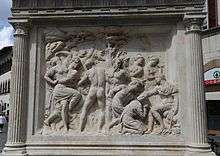Monument to Giovanni delle Bande Nere, Florence
The Monument to Giovanni delle Bande Nere is a Reinaissance-style marble, outdoor sculptural group located in Piazza San Lorenzo in Florence, region of Tuscany, Italy.
History
The statue was originally commissioned by Cosimo I de Medici in 1540 to commemorate his father, Giovanni delle Bande Nere, the successful condottiero from the Medici family. The sculptor was Baccio Bandinelli. The statue however was controversial from the start: it was debated whether a depiction of an armed soldier should serve as a monument in a church, however even if it was not displayed in a church, it was debated if it was appropriate for a warrior like Giovanni, who had marched against foes most of his life, to be immortalized while sitting down.
The contract called for completion of the statue and bas-reliefs within two years, but upon Bandinelli's death in 1560, the latter remained unfinished. The statue itself found a home in the large Hall of Palazzo Vecchio, but the base remained in the Neroni Chapel of the Basilica of San Lorenzo. In 1620, Cosimo II de Medici had the base or plinth moved to the Piazza where it stands. In 1812, Giuseppe Del Rosso created a fountain around it, with lion head intermingled with Medici coat of arms. The statue of Giovanni delle Bande, however, secured the heights of the plinth only in 1850, under work directed by the engineer Alessandro Manetti. A satiric ditty from the occasion claimed:
Sir Giovanni delle Bande Nere (Messer Giovanni delle Bande Nere)from a long ride weary and tired (dal lungo cavalcar noiato e stanco)
dismounts from saddle, and settles on seat. (scese di sella e si pose a sedere)

The imposing Giovanni sits, somewhat uncomfortably, wearing a metallic cuirass on his torso. Without a helmet or army boots, he holds a baton of command on his knee. The plinth is almost more decorative with festoons and Bucranium, and corner doric columns. One bas-relief appears to show soldiers bringing booty and captives before a sitting ruler. Others depict the Medici Coat of Arms. The corners have doric pilaster-columns.
The 19th-century plaque reads in translation:[1]One part of this monument/ destined by Cosimo I/ to honor the memory of his father/ Giovanni delle Bande Nere/ by no choice stood/ and commonly called the Base of San Lorenzo/ Restored in 1850/ and made to host the statue of the great captain/ becoming finally complete the prized work/ sculpted by Bandinelli. The long excuse gave rise to a contemporary joke that the statue was dedicated to Great Captain Becoming (Gran Capitano Ebbe).[2][3] Coordinates: 43°46′30.04″N 11°15′17.88″E / 43.7750111°N 11.2549667°E
References
- ↑ UNA PARTE DI QUESTO MONUMENTO/ DESTINATO DA COSIMO PRIMO/ AD ONORARE LA MEMORIA DEL PADRE/ GIOVANNI DELLE BANDE NERE/ LUNGAMENTE NON CURATA QUI STETTE/ E IL VOLGO LA CHIAMÒ LA BASE DI SAN LORENZO/ RESTAURATA NELL'ANNO MDCCCL/ E POSTAVI LA STATUA DEL GRAN CAPITANO/ EBBE ALFINE COMPIMENTO LA PREGEVOLE OPERA/ SCOLPITA DAL BANDINELLI
- ↑ Passeggiate fiorentine di un maestro e dei suoi scolari, by Filippo Pasquinelli, (1898): page 19-20.
- ↑ Palazzo Spinelli, Repertorio delle Architetture Civile di Firenze, entry by Claudio Paolini.